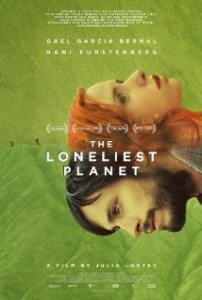Low-key narrative is one of the most frequent characteristics of indie film, a tendency that sometimes veers towards the minimalist end of the scale in the kind of production in which, by conventional standards, ‘very little happens’. A good example of the potency that can be created in this domain is Julia Loktev’s The Loneliest Planet (2011), which offers what feels almost close to a documentation – rather than dramatization – of the experiences of a couple trekking with a guide across spectacular landscapes in the Caucasus mountains of Georgia. It’s not a documentation but a fictional piece, but the emphasis for most of the running time – at 113 minutes quite lengthy for this kind of material – is on evoking an impression simply of transition through the land, accompanied by occasional dialogue and various undramatized activities along the way.
But there is one piece of what, in itself, seems more conventional ‘movie’ action – spoiler alert here, if you’ve not seen the film and want to experience it fully in its own right, do so before reading on. As we watch a film of this kind, depending on how exactly we’ve been prepared, what foreknowledge we have, we are inclined to wonder if something of this kind is going to happen. Early on, the central couple – Alex (Gael Garcia Bernal) and Nica (Hani Furstenberg) – are in a bar where a group of local men encourage them to join them in dancing. Nothing happens, but there’s a distinct feeling here of potential threat, the potency of which is in some ways greater for not being realised. They move on to hire a guide, Dato (played by a real local guide, Bidzina Gujabidze), and head into the vast empty, hills, the charting of their progress punctuated by extreme long-shot sequences in which their figures move across the screen, dwarfed by the vastness of place and the evocation of its textures.
Then, some 50 minutes in, comes an event of more movie-conventionally dramatic kind. Their paths are crossed by those of a small group including an older man who has a long-barrelled gun slung across his shoulders. After seemingly angry, untranslated comments by a youth, the elder member of the party suddenly points the gun at Alex. His first, seemingly instinctive move, is to pull Nica in front of him, as if to use her as cover, although the then pushes her behind him as the gun rests immediate in front of his face. Some seconds pass – slowly, filled with tension – before the gun is removed, the man offers an apology and his group continue on their way.
This dramatic incident does not become the basis of an obvious major plot point such as a robbery or kidnapping, as might be expected in a more conventional dramatic feature. But it casts a powerful effect across the rest of the film. Nica gathers up her backpack and continues the trek, the others following, Alex at some distance. We see them walking on in the following sequences, much further apart than they have been up to this point. Not a word is said about the event, their reaction to it, or any transgression Alex might be considered to have committed. The general tenor of the film remains the same, the experiences of the characters seemingly pushed largely to the margins. What the film demonstrates in this way is how less can, indeed, become more; how the very limited deployment of ‘dramatic action’ can add hugely to the effect that it generates, pound-for-pound, as it were. The only other notable event in the film is a lengthy kiss exchanged by Nica and Dato close to the end, after the pair have sat up drinking by their camp fire after Alex has retired. The Loneliest Planet closes with the packing up of tents the following morning, but there is no sense of closure – not even the completion of the journey, let alone any indication of what all this means for the relationship between the central characters (the only background information about which is the fact that they are due to marry in the near future).
For some, of course, this might be rather unsatisfying, and such films tend to provoke very divided reaction, critically and more widely (see also, for example, the films of Kelly Reichardt, which I write about in Indie 2.0: Change and Continuity in Contemporary American Indie Film, due out soon!). Powerful poetic minimalism – or boredom? All just a matter of taste – although, of course, there’s no ‘just’ about it, but core articulations of varying forms of cultural capital of the kind that go to the heart of processes of cultural consumption more widely.



